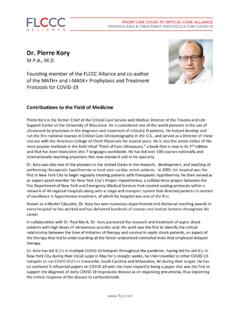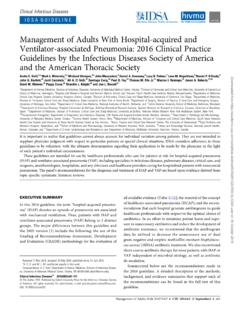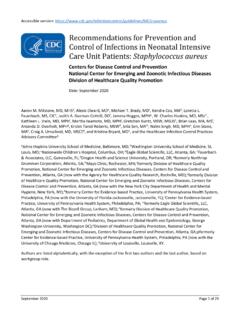Transcription of GUIDELINES FOR PREVENTING HEALTH-CARE-ASSOCIATED …
1 GUIDELINES FOR PREVENTING HEALTH-CARE-ASSOCIATED PNEUMONIA, 2003 Recommendations of CDC and the Healthcare Infection Control Practices Advisory Committee Accessible version: Prepared By:Ofelia C. Tablan, J. Anderson, Besser, Bridges, Hajjeh, of Healthcare Quality Promotion, National Center for Infectious Diseases , CDC2 Division of Viral and Rickettsial Diseases, NCID, CDC3 Division of Bacterial and Mycotic Diseases, NCID, CDCThe material in this report originated in the National Center for Infectious Diseases, James M.
2 Hughes, , Director, Division of Healthcare Quality Promotion, Denise M. Cardo, , Director, and the Division of Bacterial and Mycotic Diseases, Mitchell L. Cohen, , INFECTION CONTROL PRACTICES ADVISORY COMMITTEEC hair: Robert A. Weinstein, , Cook County Hospital, Chicago, IllinoisCo-Chair: Jane D. Siegel, , University of Texas Southwestern Medical Center, Dallas, TexasExecutive Secretary: Michele L. Pearson, , CDC, Atlanta, GeorgiaMembers: Raymond Chinn, , Sharp Memorial Hospital, San Diego, California; Alfred DeMaria, Jr.
3 , , Massachusetts Department of Public Health, Jamaica Plains, Massachusetts; Elaine L. Larson, , ,Columbia University School of Nursing, New York, New York; James T. Lee, , , Veterans AffairsMedical Center, University of Minnesota, St. Paul, Minnesota; Ramon E. Moncada, ,Coronado Physician sMedical Center Coronado, California; William A. Rutala, ; University of North Carolina School ofMedicine, Chapel Hill, North Carolina; William E. Scheckler, ; University of Wisconsin Medical School,Madison, Wisconsin; Beth H. Stover, Kosair Children s Hospital, Louisville, Kentucky; Marjorie Underwood,Mt.
4 Diablo Medical Center, Concord, Representatives: Loretta L. Fauerbach, , CIC, Association for Professionals of Infection Control and Epidemiology, Inc., Shands Hospital at University of Florida, Gainesville, Florida; Sandra L. Fitzler, , American Healthcare Association, Washington, ; Dorothy M. Fogg, , , , Association of periOperative Registered Nurses, Denver, Colorado; Stephen F. Jencks, , , Center for Medicare and Medicaid Services, Baltimore, Marynalnd; Chiu S. Lin, , Food and Drug Administration, Rockville, Maryland; James P. Steinberg, Society for Healthcare Epidemiology of America, Inc.
5 , Crawford Long Hospital, Atlanta, Georgia; Michael L. Tapper, , Advisory Committee for the Elimination of Tuberculosis, Lennox Hill Hospital, New York, New ..3 Introduction ..4 Key terms used in the GUIDELINES .. 5 Abbreviations used in the GUIDELINES ..5 Part I. BackgroundHealth- care -associated bacterial pneumonia ..7 HEALTH-CARE-ASSOCIATED legionnaires disease ..25 HEALTH-CARE-ASSOCIATED pertussis ..32 HEALTH-CARE-ASSOCIATED viral respiratory syncytial virus parainfluenza adenovirus acute respiratory II. RecommendationsCategorization of and control of HEALTH-CARE-ASSOCIATED bacterial and control of HEALTH-CARE-ASSOCIATED legionnaires and control of HEALTH-CARE-ASSOCIATED and control of HEALTH-CARE-ASSOCIATED and control of HEALTH-CARE-ASSOCIATED respiratory syncytial virus, parainfluenza and adenovirus and control of HEALTH-CARE-ASSOCIATED acute respiratory III.
6 Performance report updates, expands, and replaces the previously published CDC "Guideline forPrevention of Nosocomial Pneumonia . The new GUIDELINES are designed to reduce the incidenceof HEALTH-CARE-ASSOCIATED pneumonia and other severe, acute lower respiratory tract infections inacute- care hospitals and in other health- care settings ( , ambulatory and long-term careinstitutions) and other facilities where health care is provided. Among the changes in the recommendations to prevent bacterial pneumonia, especiallyventilator-associated pneumonia, are the preferential use of oro-tracheal rather than naso-tracheal tubes in patients who receive mechanically assisted ventilation, the use of noninvasiveventilation to reduce the need for and duration of endotracheal intubation, changing thebreathing circuits of ventilators when they malfunction or are visibly contaminated, and (whenfeasible)
7 The use of an endotracheal tube with a dorsal lumen to allow drainage of respiratorysecretions; no recommendations were made about the use of sucralfate, histamine-2 receptorantagonists, or antacids for stress-bleeding prophylaxis. For prevention of health- care -associatedLegionnaires disease, the changes include maintaining potable hot water at temperatures notsuitable for amplification of Legionella spp., considering routine culturing of water samples fromthe potable water system of a facility s organ-transplant unit when it is done as part of thefacility s comprehensive program to prevent and control HEALTH-CARE-ASSOCIATED Legionnairesdisease, and initiating an investigation for the source of Legionella spp.
8 When one definite or onepossible case of laboratory-confirmed HEALTH-CARE-ASSOCIATED Legionnaires disease is identifiedin an inpatient hemopoietic stem-cell transplant (HSCT) recipient or in two or more HSCT recipients who had visited an outpatient HSCT unit during all or part of the 2-10 day periodbefore illness onset. In the section on aspergillosis, the revised recommendations include the useof a room with high-efficiency particulate air filters rather than laminar airflow as the protectiveenvironment for allogeneic HSCT recipients, and the use of high-efficiency respiratory-protectiondevices ( , N95 respirators) by severely immunocompromised patients when they leave theirrooms when dust-generating activities are ongoing in the facility.
9 In the respiratory syncytialvirus (RSV) section, the new recommendation is to determine, on a case-by-case basis, whether toadminister monoclonal antibody (palivizumab) to certain infants and children aged <24 monthswho were born prematurely and are at high risk for severe RSV infection. In the section oninfluenza, the new recommendations include the addition of oseltamivir (to amantadine andrimantadine) for prophylaxis of all patients without influenza illness and oseltamivir andzanamivir (to amantadine and rimantadine) as treatment for patients who are acutely ill withinfluenza in a unit where an influenza outbreak is addition to the revised recommendations, the guideline contains new sections on pertussis andlower respiratory tract infections caused by adenovirus and human parainfluenza viruses, andrefers readers to the source of updated information about prevention and control of severe acuterespiratory of the high morbidity and mortality associated with HEALTH-CARE-ASSOCIATED pneumonia.
10 Several GUIDELINES for its prevention and control have been published. The first CDC Guideline forPrevention of Nosocomial Pneumonia was published in 1981 and addressed the main infection-control problems related to hospital-acquired pneumonia at the time: the use of large-volumenebulizers that were attached to mechanical ventilators and improper reprocessing ( , cleaningand disinfection or sterilization) of respiratory- care equipment. The document also covered theprevention and control of hospital-acquired influenza and respiratory syncytial virus (RSV) 1994, the Healthcare Infection Control Practices Advisory Committee (HICPAC) (then knownas the Hospital Infection Control Practices Advisory Committee) revised and expanded the CDCG uideline for Prevention of Nosocomial Pneumonia to include Legionnaires disease and pulmonaryaspergillosis (1).













